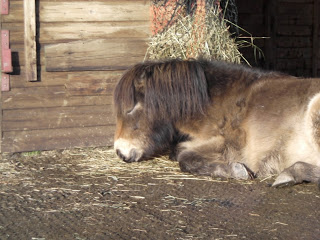So, after letting my thoughts on autonomous vs. controlled motivation settle a bit, my feeling is that this stuff does have a lot of relevance to horse training, and is a useful way of thinking about how we train horses.
To recap, my understanding is that controlled motivation is the usual 'method' of training animals, whether it be carrot or stick. Autonomous motivation is where you don't externally motivate (I will hurt you if you don't/I will give you a sweetie if you do) but rather create conditions in which they can make choices and motivate themselves.
In the real world even the most well-off humans have a mixture of controlled and autonomous motivation going on. There are things we do, like pay our taxes, simply to avoid punishment. We may do a job we don't much like to get money, and so on. But we don't put much 'heart' into these things. Controlled motivation isn't much fun, basically, so the less there is of it the better, but there will always be some!
Pure autonomous motivation isn't going to be a realistic goal with horses either, even if we wanted it. For most horses anyway. For example, say I was training up a youngster for sale, and teaching him to stand for the farrier. I'm really looking for him to behave in a way that is regarded as good by most people, and for him to be comfortable with it. I don’t want him to be creative, or self-motivated particularly, I am simply training a particular behaviour.
So, can I think of examples of autonomous motivation, or areas relating to it?
1. Something people have recognised for centuries – give a horse a job he actually enjoys, and he’ll probably be good at it. Take 2 horses who are starting jumping – if one seems to enjoy it (whole other can of worms there, but never mind, will move swiftly on ;-)) and the other will jump well when you hold a carrot out after the jump but not otherwise – which would you think would make the better jumper? Similarly, I wouldn't aim to do endurance with a horse who didn't seem to enjoy being ridden out but had to be encouraged to go with an external motivator.
2. I think I had an example of autonomous motivation when I was riding at a clinic about a month ago – great connection with the horse, all going well, then I dropped my reins to give him a scratch as a reward and ruined it! The balance and ease of movement we were achieving felt good to him, he was enjoying what we were doing together and didn’t need an explicit reward – in fact is seemed to spoil things!
3. Another thing good trainers have been doing for a long time – where possible, when the horse is learning, give them choices. This is more tenuous, but I think it’s the same kind of thing. Say your horse doesn't stop on a light aid. You could move up to inflicting pain - saying the only behaviour that is acceptable to me right now is that you stop – you are attempting to remove choice. Or, you could say ‘if you can’t stop right now, I won’t try to force you, but we will have to move in a circle. We can circle for as long as we need to, it’s genuinely fine with me’. OK, that’s a very engineered choice, but it’s still giving the horse space to think for himself and learn.
So, we can train a behaviour (such as going over a jump) using carrot or stick (controlled motivation), but if the horse doesn't actually want to jump, we won't get any quality. People are not too surprised when we see conflict behaviours in horses when we use the 'stick' approach to motivate him to do something he doesn't want to do. More surprising, maybe, is that the 'carrot' approach could also produce conflict in the horse if, say, a treat is offered in return for some behaviour that he finds aversive, and withheld otherwise – forcing the horse to deal with conflicting motivations.
This last point is especially interesting, maybe, in the context of clicker training. What I'm picking up on isn't new - quite a number of clicker trainers and horse behaviour people have been discussing this for a while now. It's easy to believe you can't go far wrong in terms of equine welfare with a clicker and a pocket full of sweeties (I've been there!) but if your horse isn't coming to enjoy, or at least feel OK about the actual training you are doing, you could be creating more problems than you are solving!



